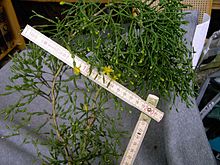- Rhipsalis salicornioides
-
Rhipsalis salicornioides 
Rhipsalis salicornioides with many buds and a few open flowers. Scientific classification Kingdom: Plantae (unranked): Angiosperms (unranked): Eudicots (unranked): Core eudicots Order: Caryophyllales Family: Cactaceae Genus: Rhipsalis Species: R. salicornioides Binomial name Rhipsalis salicornioides Rhipsalis salicornioides (also called Hatiora salicornioides, Dancing Bones Cactus, Drunkard's Dream, Spice Cactus) is originally a forest cactus, growing as epiphytes at elevations between 0 and 1850 meters in Brazil. It is sometimes grown both indoors and outdoors as an ornamental.
The plant is made of many-branched stems that are up to 60 cm in length. A stem consists of smaller segments with a length of up to 3 cm. The segment has a shape that resemble a bottle. The contorted stems may account for the common names "Dancing Bones Cactus" and "Drunkard's Dream", or the bottle shape of the segments may account for the latter.
Contents
Flowers
Rhipsalis salicornioides has small deep yellow flowers that develop to translucent berries with a reddish end.
Synonymy
Other Latin names for Rhipsalis salicornioides are: Hatiora salicornioides var. stricta, Hariota stricta, Hariota salicornioides var. villigera, Hariota villigera, Rhipsalis villigera, Rhipsalis salicornioides var. villigera, Rhipsalis salicornioides var. stricta, Hatiora salicornioides var. villigera, Rhipsalis stricta, Rhipsalis bambusoides, Rhipsalis salicornioides var. bambusoides, Hariota bambusoides, Hatiora bambusoides, Hariota salicornioides var. bambusoides.
Uncertain synonym for Rhipsalis salicornioides: Rhipsalis teres.
The generic name Hatiora is an anagram of Hariota, honoring Thomas Hariot, an English scientist, historian, and mentor of Sir Walter Raleigh.calhortsociety.org. The species name salicornoides comes from its shape similar to Salicornia.
See also
- Rhipsalis
- Schlumbergera
- Cactus
- succulent
References
- Page on Rhipsalis salicornioides from davesgarden.com with photographs of plants and flowers
- Page from desert-tropicals.com
- Page from the California Horticultural Society's Plant Forums with close-up photograph
External links
- Page from Anwyl Bromeliads with photographs of the plant and flowers
- plantoftheweek.org
- cactiguide.com
- TopTropicals.com

This Cactaceae article is a stub. You can help Wikipedia by expanding it.
